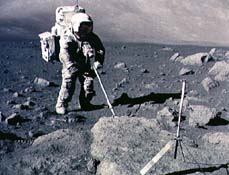If there were astronauts on the Moon, could we see them?

NASA
I get some variant of this question almost every time I show someone his or her first view of the Moon through a telescope, especially at high magnification. The breathtaking sight of lunar craters, mountains, and other features down to the limit of perception makes us think we’re seeing much finer details than we really are.
A convenient expression of the resolution of a telescope used visually is the Dawes limit, which says that the smallest angle we can resolve (in arcseconds) equals 116/D, where D is the aperture’s diameter in millimeters. If we could look at the Moon through the Hubble Space Telescope, for which D is 2,400 mm (94.5 inches), we’d be able to discern surface features as small as 0.05 arcsecond. When the Moon is closest to Earth, only 356,000 kilometers (221,000 miles) away, 0.05 arcsecond corresponds to about 85 meters (280 feet). Not only is this insufficient to resolve a person on the Moon, but it’s not even good enough to detect the 10-meter-wide Apollo landers left there in the 1960s and ’70s.
So how big a telescope would it take to see a moonwalker? To get less than 2-meter (6-foot)resolution when the Moon is closest, we’d need a telescope able to resolve angles as small as 0.001 arcsecond. That translates into a diameter exceeding 100 meters (4,000 inches). And this behemoth would have to be in space, too, since atmospheric seeing limits even the biggest ground-based scopes to an angular resolution of at best a half arcsecond or so, corresponding to lunar features no smaller than about 1 km (0.6 mile).
— Richard Tresch Fienberg
 0
0







Comments
You must be logged in to post a comment.